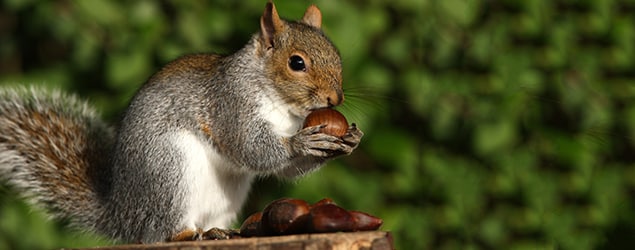Bringing back the chestnut (#GMOMonday)

Squirrels are famous for their bushy tails and leaping ability, and it is well known that nuts are their preferred snack. Thanks to genetic engineering, soon squirrels from Florida to Maine could be hiding a nut they haven’t seen in over 60 years: the American chestnut.
When settlers first came to America, American chestnut trees would have been a prominent part of the forest. There were over 4 billion trees which produced billions of pounds of chestnuts every year for both squirrels and people to collect. The nuts fell from groves in a seemingly boundless supply of shiny brown gems that could be scooped up and crushed to make bread, roasted or eaten raw. People also desired the trees for their hardwood—they grow faster than oaks and produce a strong wood that is easy to split. Back in 1900 chestnut made up about 25% of all mature timber in the United States.
Their tremendous size earned them the nickname “the redwood of the East.” But the giant trees were virtually wiped out by an enemy thousands of times their junior. In 1904, people began to notice that the trees were dying off, and it was discovered that a fungus was to blame. This chestnut blight fungus was brought to America on imported Asian chestnut tree saplings. The Asian trees were immune to the fungus, but the American trees were not. Soon the fungus leapt from chestnut tree to chestnut tree and by 1950, the American chestnut was virtually wiped out.
The fungus was so deadly that there is only a short list of all remaining specimens. In 2008 it was announced that a mature tree had been discovered in a marsh near Lake Erie. The tree was so rare that officials had kept its existence secret for seven years.
Since the fungus was discovered, scientists worked to try to save the trees by creating hybrid versions of the American chestnut by crossing it with other chestnut trees. But these were only sometimes immune, and since nobody really knew which genes offered the resistance, it was a long, laborious process of “breed and check.” To make matters worse, the American chestnut has some properties that make it particularly desirable, such as a thin shell which makes it easy to eat. The nuts are also smaller and more flavorful than their cousins—hybrid varieties would also have to capture that special taste if they were to be fully successful. Research continues into a hybrid solution, but two decades ago, scientists decided to attack the problem from a different angle.
The search for a genetic engineered solution was begun in 1990 by researchers William Powell and Scott Merkle. Genomes from both the American and Chinese chestnut trees were mapped, and the genes that seemed to give these trees immunity from the blight were flagged. But the big discovery came from another plant entirely. The team noticed that the chestnut blight fungus generates oxalic acid, which causes many of the symptoms that kill chestnut trees. Dr. Powell discovered that wheat creates an enzyme called oxalate oxidase that detoxifies the oxalic acid.
Powell and his collaborators have now created a number of American chestnut trees that include genes from Chinese chestnut trees, other chestnut blight immune trees and, of course, the special wheat gene. A group of 800 of these precisely engineered trees were planted in May to see how they fare against the blight.
If the experiment is a success, genetic engineers could finally bring the legendary chestnut back to America. Imagine the possibilities: sitting in your chestnut wood chair as you stare at tasty chestnuts roasting on an open fire, thinking about the squirrels sleeping in their new chestnut tree burrows.
And this is just one of countless ways that scientists are using our understanding of genetics to make all kinds of similar improvements to our food. What do you think? Chime in on Twitter using the hashtag #GMOMonday.



